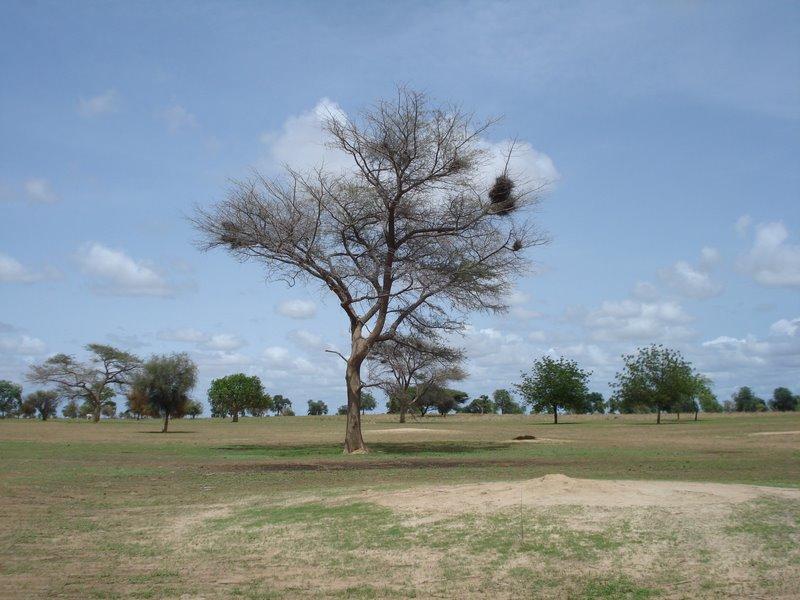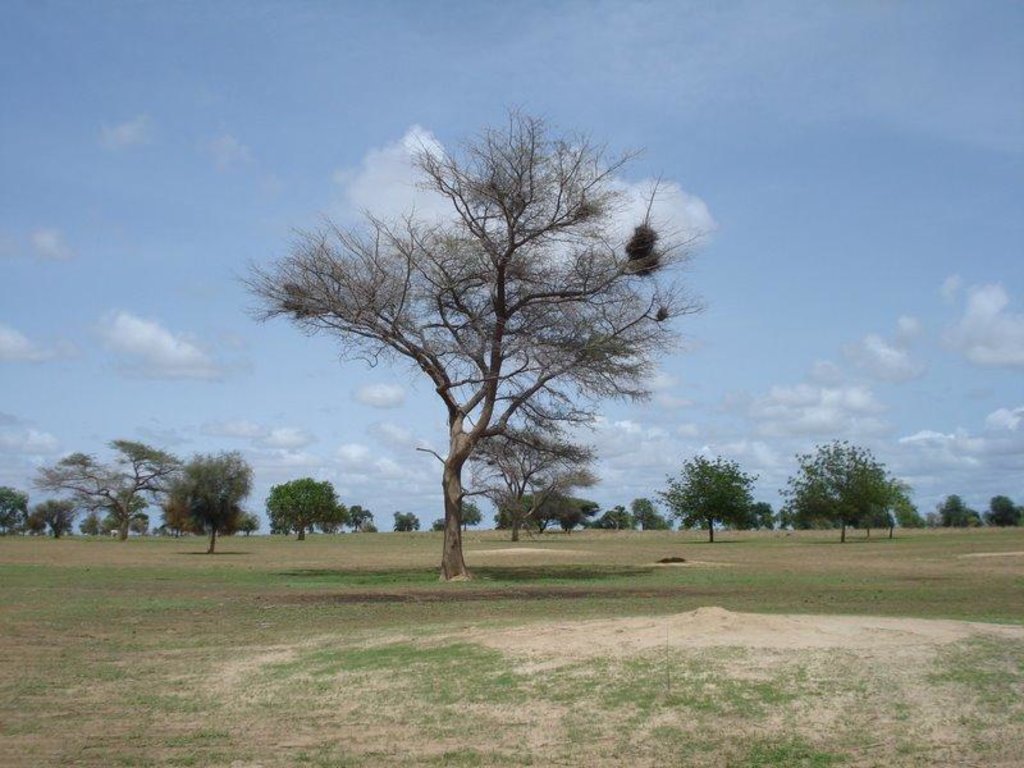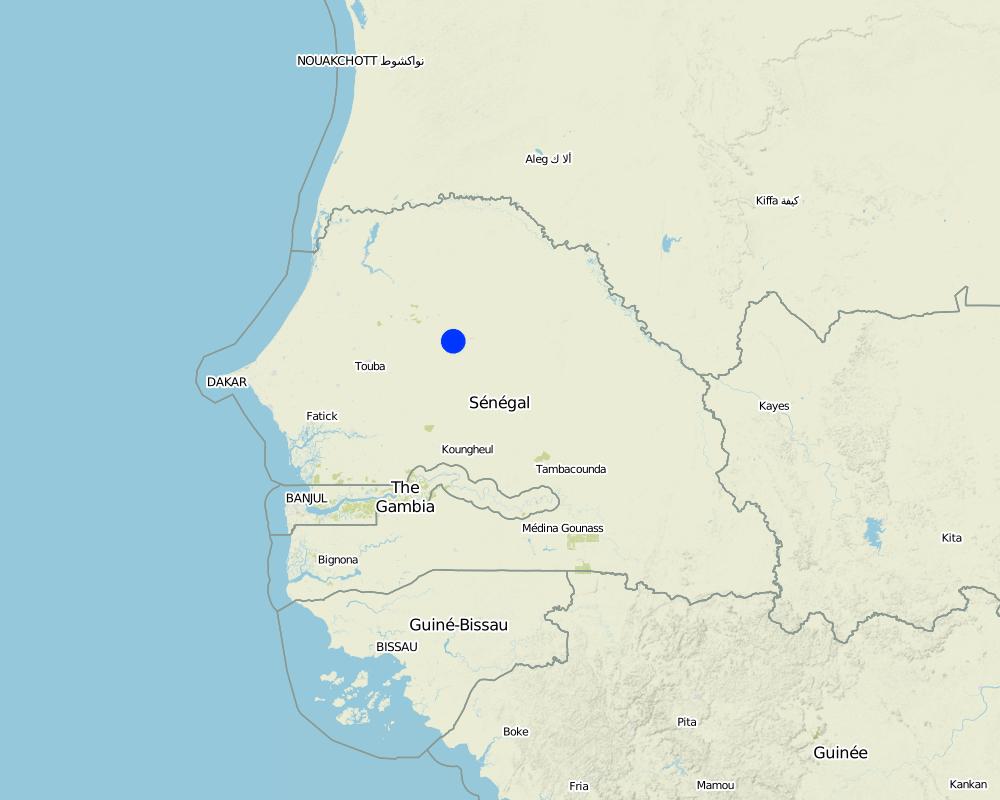Agroforestry parkland [Senegal]
- Creation:
- Update:
- Compiler: Julie Zähringer
- Editor: –
- Reviewer: Fabian Ottiger
technologies_1167 - Senegal
View sections
Expand all Collapse all1. General information
1.2 Contact details of resource persons and institutions involved in the assessment and documentation of the Technology
SLM specialist:
Name of the institution(s) which facilitated the documentation/ evaluation of the Technology (if relevant)
CDE Centre for Development and Environment (CDE Centre for Development and Environment) - SwitzerlandName of the institution(s) which facilitated the documentation/ evaluation of the Technology (if relevant)
CSE (CSE) - Senegal1.3 Conditions regarding the use of data documented through WOCAT
When were the data compiled (in the field)?
19/08/2009
The compiler and key resource person(s) accept the conditions regarding the use of data documented through WOCAT:
Yes
2. Description of the SLM Technology
2.1 Short description of the Technology
Definition of the Technology:
A traditional agroforestry parkland with scattered trees beneficial for soil properties (e.g. Faidherbia albida) or providing food for human beings and cattle (e.g. Sclerocarya birrea)
2.2 Detailed description of the Technology
Description:
Between scattered trees of which some were carefully selected for their positive influence on soil properties, either millet (Pennisetum typhoides), groundnut (Arachis hypogaea) or watermelon (Citrullus lanatus) are grown in rotation. The dominant tree species are Faidherbia albida (syn. Acacia albida), Sclerocarya birrea, Sterculia setigera and Combretum glutinosum. Some of the species were introduced from elsewhere and planted by land users when they settled in the area. Other species regenerated naturally in the fields and were protected till they reached mature age. F. albida sheds it's leaves at the beginning of the rainy season increasing soil nutrient stock for the cultivation period and reducing competition with crops for light. Sclerocarya birrea is widely appreciated by cattle for it's nutritious fruits. Cattle resting in the shade of the large trees provide free organic manure. Mulching and manure application are common means to improve soil organic matter and nutrient content in this remote area where access to inorganic fertilizers is very limited due to inaccessibility.
Purpose of the Technology: The main objectives of this parkland system are to enhance crop production through improvement of soil properties with the help of trees, the provision of supplementary food for cattle in the form of fruits and the availability of certain plants (or parts of them) for traditional medicine.
Establishment / maintenance activities and inputs: The technology has a long tradition in more southern regions of Sénégal and was brought to the Ferlo by Wolof people that moved to this zone in the search for cultivable area. Knowledge is transferred from parents to their children. Except for the purchase of seeds for cultivation of the fields there is no financial inputs required for this system.
Natural / human environment: This SLM technology site is located in the sylvopastoral region of the Ferlo in the north of Sénégal. The agro-climatic zone is classified as semi-arid with mean annual precipitation of 300-400 mm. Rainfed agriculture under agroforestry parkland in a belt around the main village is the main landuse type in the area. In a second circle, extensive pastoralism is practiced and forest resources are being exploited. Presence of insects and wild animals (monkeys, warthogs) damaging cultures and the lack of sufficient rainfall are main constraints mentioned by landusers in the area. Degradation of vegetation cover is widespread. The bare soils are prone to wind erosion, a common phenomenon in the area, carrying away the arable soil horizon and causing a decline in soil fertility. In general, the local population has signaled a decline of land degradation due to the widely practiced tradition of SLM technologies.
2.3 Photos of the Technology
2.5 Country/ region/ locations where the Technology has been applied and which are covered by this assessment
Country:
Senegal
Region/ State/ Province:
Louga
Further specification of location:
Linguère / Barkédji
Map
×2.6 Date of implementation
If precise year is not known, indicate approximate date:
- more than 50 years ago (traditional)
2.7 Introduction of the Technology
Specify how the Technology was introduced:
- as part of a traditional system (> 50 years)
Comments (type of project, etc.):
introduced from the more southern parts of Sénégal by Wolof farmers
3. Classification of the SLM Technology
3.1 Main purpose(s) of the Technology
- improve production
- reduce, prevent, restore land degradation
- conserve ecosystem
- preserve/ improve biodiversity
- create beneficial economic impact
3.2 Current land use type(s) where the Technology is applied

Mixed (crops/ grazing/ trees), incl. agroforestry
- Agroforestry
Main products/ services:
Major cash crop: Millet, groundnut, watermelon
Major food crop: Millet, groundnut, watermelon
Comments:
Major land use problems (compiler’s opinion): deforestation, wind erosion causing loss of topsoil
Major land use problems (land users’ perception): rain insufficience and presence of insect pests
3.3 Further information about land use
Water supply for the land on which the Technology is applied:
- rainfed
Number of growing seasons per year:
- 1
Specify:
Longest growing period in days: 120 Longest growing period from month to month: Jul-Oct
3.4 SLM group to which the Technology belongs
- agroforestry
- improved ground/ vegetation cover
- improved plant varieties/ animal breeds
3.5 Spread of the Technology
Specify the spread of the Technology:
- evenly spread over an area
If the Technology is evenly spread over an area, indicate approximate area covered:
- 0.1-1 km2
3.6 SLM measures comprising the Technology

agronomic measures
- A2: Organic matter/ soil fertility

vegetative measures
- V1: Tree and shrub cover
Comments:
Main measures: vegetative measures
Secondary measures: agronomic measures
Type of agronomic measures: mulching, manure / compost / residues
3.7 Main types of land degradation addressed by the Technology

soil erosion by wind
- Et: loss of topsoil

chemical soil deterioration
- Cn: fertility decline and reduced organic matter content (not caused by erosion)

biological degradation
- Bc: reduction of vegetation cover
- Bh: loss of habitats
- Bq: quantity/ biomass decline
- Bs: quality and species composition/ diversity decline
Comments:
Main type of degradation addressed: Et: loss of topsoil, Cn: fertility decline and reduced organic matter content, Bc: reduction of vegetation cover, Bs: quality and species composition /diversity decline
Secondary types of degradation addressed: Bh: loss of habitats, Bq: quantity / biomass decline
Main causes of degradation: deforestation / removal of natural vegetation (incl. forest fires) (due to domestic uses), over-exploitation of vegetation for domestic use, overgrazing (oversized herds of cattle), droughts, population pressure, poverty / wealth (poverty)
Secondary causes of degradation: education, access to knowledge and support services
3.8 Prevention, reduction, or restoration of land degradation
Specify the goal of the Technology with regard to land degradation:
- prevent land degradation
4. Technical specifications, implementation activities, inputs, and costs
4.2 Technical specifications/ explanations of technical drawing
Technical knowledge required for field staff / advisors: low
Technical knowledge required for land users: low
Main technical functions: increase in organic matter, increase in nutrient availability (supply, recycling,…)
Secondary technical functions: stabilisation of soil (eg by tree roots against land slides), reduction in wind speed, increase of biomass (quantity)
Mulching
Material/ species: plant residues after harvest
Manure / compost / residues
Material/ species: manure from cattle faeces
Scattered / dispersed
Vegetative material: T : trees / shrubs
Number of plants per (ha): 8
Trees/ shrubs species: Faidherbia albida, Sclerocarya birrea, Sterculia setigera, Piliostigma reticulata, Balanties aegypti
4.4 Establishment activities
| Activity | Type of measure | Timing | |
|---|---|---|---|
| 1. | selection or planting of trees | Vegetative | |
| 2. | removal of unwanted tree species | Vegetative |
4.5 Costs and inputs needed for establishment
| Specify input | Unit | Quantity | Costs per Unit | Total costs per input | % of costs borne by land users | |
|---|---|---|---|---|---|---|
| Plant material | Seeds | 1.0 | 1.68 | 1.68 | 100.0 | |
| Total costs for establishment of the Technology | 1.68 | |||||
Comments:
Lifespan of the product: 1 season (120 days)
4.6 Maintenance/ recurrent activities
| Activity | Type of measure | Timing/ frequency | |
|---|---|---|---|
| 1. | application of manure and mulching | Agronomic | |
| 2. | sowing of millet / groundnut | Agronomic | june |
4.7 Costs and inputs needed for maintenance/ recurrent activities (per year)
Comments:
No cost is involved with organic manure as it can be obtained by giving nomadic Fula herders the right to let their cattle rest in the shade under the trees or feed on plant residues
5. Natural and human environment
5.1 Climate
Annual rainfall
- < 250 mm
- 251-500 mm
- 501-750 mm
- 751-1,000 mm
- 1,001-1,500 mm
- 1,501-2,000 mm
- 2,001-3,000 mm
- 3,001-4,000 mm
- > 4,000 mm
Specifications/ comments on rainfall:
300-400 mm during one rainy season / length of dry period: 9 months
Agro-climatic zone
- semi-arid
Thermal climate class: tropics
5.2 Topography
Slopes on average:
- flat (0-2%)
- gentle (3-5%)
- moderate (6-10%)
- rolling (11-15%)
- hilly (16-30%)
- steep (31-60%)
- very steep (>60%)
Landforms:
- plateau/plains
- ridges
- mountain slopes
- hill slopes
- footslopes
- valley floors
Altitudinal zone:
- 0-100 m a.s.l.
- 101-500 m a.s.l.
- 501-1,000 m a.s.l.
- 1,001-1,500 m a.s.l.
- 1,501-2,000 m a.s.l.
- 2,001-2,500 m a.s.l.
- 2,501-3,000 m a.s.l.
- 3,001-4,000 m a.s.l.
- > 4,000 m a.s.l.
5.3 Soils
Soil depth on average:
- very shallow (0-20 cm)
- shallow (21-50 cm)
- moderately deep (51-80 cm)
- deep (81-120 cm)
- very deep (> 120 cm)
Soil texture (topsoil):
- coarse/ light (sandy)
Topsoil organic matter:
- medium (1-3%)
- low (<1%)
If available, attach full soil description or specify the available information, e.g. soil type, soil PH/ acidity, Cation Exchange Capacity, nitrogen, salinity etc.
Soil fertility: High
Soil drainage / infiltration: Good
Soil water storage capacity: High
5.4 Water availability and quality
Availability of surface water:
poor/ none
Water quality (untreated):
poor drinking water (treatment required)
5.5 Biodiversity
Species diversity:
- medium
5.6 Characteristics of land users applying the Technology
Market orientation of production system:
- subsistence (self-supply)
- mixed (subsistence/ commercial
Off-farm income:
- less than 10% of all income
Relative level of wealth:
- poor
- average
Individuals or groups:
- groups/ community
Level of mechanization:
- animal traction
Indicate other relevant characteristics of the land users:
Land users applying the Technology are mainly common / average land users
Population density: < 10 persons/km2
Annual population growth: 2% - 3%
30% of the land users are average wealthy.
70% of the land users are poor.
Off-farm income specification: livestock raising
Level of mechanization: Animal traction (by horse)
5.7 Average area of land owned or leased by land users applying the Technology
- < 0.5 ha
- 0.5-1 ha
- 1-2 ha
- 2-5 ha
- 5-15 ha
- 15-50 ha
- 50-100 ha
- 100-500 ha
- 500-1,000 ha
- 1,000-10,000 ha
- > 10,000 ha
Is this considered small-, medium- or large-scale (referring to local context)?
- small-scale
5.8 Land ownership, land use rights, and water use rights
Land ownership:
- state
- individual, not titled
Land use rights:
- communal (organized)
Water use rights:
- communal (organized)
5.9 Access to services and infrastructure
health:
- poor
- moderate
- good
education:
- poor
- moderate
- good
technical assistance:
- poor
- moderate
- good
employment (e.g. off-farm):
- poor
- moderate
- good
markets:
- poor
- moderate
- good
energy:
- poor
- moderate
- good
roads and transport:
- poor
- moderate
- good
drinking water and sanitation:
- poor
- moderate
- good
financial services:
- poor
- moderate
- good
6. Impacts and concluding statements
6.1 On-site impacts the Technology has shown
Socio-economic impacts
Production
crop production
fodder production
Comments/ specify:
fruits of Sclerocarya birrea
production area
Income and costs
farm income
Socio-cultural impacts
food security/ self-sufficiency
health situation
Comments/ specify:
because of availability of plants used in traditional medicine
Improved livelihoods and human well-being
Ecological impacts
Water cycle/ runoff
evaporation
Comments/ specify:
mulching
Soil
soil moisture
Comments/ specify:
mulching
soil cover
nutrient cycling/ recharge
soil organic matter/ below ground C
Comments/ specify:
litterfall, organic manure
Biodiversity: vegetation, animals
biomass/ above ground C
Climate and disaster risk reduction
emission of carbon and greenhouse gases
6.3 Exposure and sensitivity of the Technology to gradual climate change and climate-related extremes/ disasters (as perceived by land users)
Gradual climate change
Gradual climate change
| Season | Type of climatic change/ extreme | How does the Technology cope with it? | |
|---|---|---|---|
| annual temperature | increase | well |
Climate-related extremes (disasters)
Meteorological disasters
| How does the Technology cope with it? | |
|---|---|
| local rainstorm | well |
| local windstorm | well |
Climatological disasters
| How does the Technology cope with it? | |
|---|---|
| drought | not known |
Hydrological disasters
| How does the Technology cope with it? | |
|---|---|
| general (river) flood | not well |
Other climate-related consequences
Other climate-related consequences
| How does the Technology cope with it? | |
|---|---|
| reduced growing period | well |
6.4 Cost-benefit analysis
How do the benefits compare with the establishment costs (from land users’ perspective)?
Short-term returns:
slightly positive
Long-term returns:
very positive
How do the benefits compare with the maintenance/ recurrent costs (from land users' perspective)?
Short-term returns:
slightly positive
Long-term returns:
very positive
6.5 Adoption of the Technology
If available, quantify (no. of households and/ or area covered):
16
Of all those who have adopted the Technology, how many have did so spontaneously, i.e. without receiving any material incentives/ payments?
- 90-100%
Comments:
100% of land user families have adopted the Technology without any external material support
There is a strong trend towards spontaneous adoption of the Technology
Comments on adoption trend: the technology is already being practiced by the whole population of this village
6.7 Strengths/ advantages/ opportunities of the Technology
| Strengths/ advantages/ opportunities in the land user’s view |
|---|
|
increased crop production How can they be sustained / enhanced? protect trees in fields |
|
increased availability of fruits for humans and cattle How can they be sustained / enhanced? protection of trees producing fruits appreciated by humans or cattle |
|
increased availability of plant products used in traditional medicine How can they be sustained / enhanced? protection of trees providing these products |
| Strengths/ advantages/ opportunities in the compiler’s or other key resource person’s view |
|---|
|
increase of soil fertility and organic matter through trees How can they be sustained / enhanced? encourage further plantation or natural regeneration of tree species beneficial for soil properties |
| no costs involved with maintenance of technology |
|
carbon storage below and aboveground How can they be sustained / enhanced? increase tree density |
6.8 Weaknesses/ disadvantages/ risks of the Technology and ways of overcoming them
| Weaknesses/ disadvantages/ risks in the land user’s view | How can they be overcome? |
|---|---|
| loss of cultivable area due to trees in field |
| Weaknesses/ disadvantages/ risks in the compiler’s or other key resource person’s view | How can they be overcome? |
|---|---|
| natural regeneration practically absent, continuity of parkland threatened | tree planting or assisted natural regeneration if present |
Links and modules
Expand all Collapse allLinks
No links
Modules
No modules




